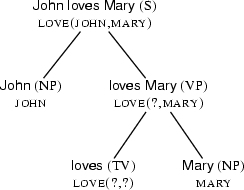3.1.2 Being Systematic (II)
Syntactic structure as missing link between the natural language sentence and its semantic representation.
Syntactic Structure...
Our missing link here is the notion of syntactic structure . ``John loves Mary'' isn't just a string of words: it has a hierarchical structure. In particular, ``John loves Mary'' is an S (sentence) that is composed of the subject NP (noun phrase) ``John'' and the VP (verb phrase) ``loves Mary''. This VP is in turn composed of the TV (transitive verb) ``loves'' and the direct object NP ``Mary''. Given this hierarchy, it is easy to tell a conclusive story about - and indeed, to draw a convincing picture of - why we should get the representation  as a result, and nothing else:
as a result, and nothing else:

...and its use for Semantics
When we combine a TV with an NP to form a VP, we have to put the semantic representation associated with the NP (in this case,  ) in the second argument slot of the VP's semantic representation (in this case,
) in the second argument slot of the VP's semantic representation (in this case,  (?,?)). And why does
(?,?)). And why does  need to be inserted into the first argument slot? Simply because this is the slot reserved for the semantic representations of NPs that we combine with VPs to form an S.
need to be inserted into the first argument slot? Simply because this is the slot reserved for the semantic representations of NPs that we combine with VPs to form an S.
In more general terms, given that we have some reasonable syntactic story about what the pieces of our sentences are, and which pieces combine with which other pieces, we can try to use this information to explain how the various semantic contributions have to be combined.
Summing up we are now in a position to give quite a good explication of ``systematicity'': When we construct meaning representations systematically, we integrate information from two different sources:
The lexical items (i.e. the words) in a sentence give us the basic ingredients for our representation.
Syntactic structure tells us how the semantic contributions of the parts of a sentence are to be joined together.